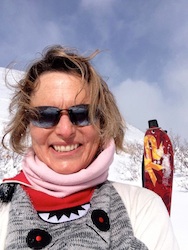 From deer mice to packrats, rodents are a common sight in southern Utah. Professor of Biology, Denise Dearing studies rodents and the dreaded hantavirus they carry.
From deer mice to packrats, rodents are a common sight in southern Utah. Professor of Biology, Denise Dearing studies rodents and the dreaded hantavirus they carry.
In her engaging presentation titled Understanding the Paradox of How More Rodents Results in Less Hantavirus: The Role of Biodiversity, Dearing explores what you need to know about rodents, hantavirus, and the role of biodiversity.
Many pathogens of wildlife and humans are transmitted through direct contacts between hosts. Dearing has been investigating the contact rates and social networks of deer mice (Peromyscus maniculatus) with respect to infection with Sin Nombre virus (aka SNV or “the hantavirus”), and the biodiversity of the mammalian community. SNV is directly transmitted between deermice during aggressive encounters.
Her research group has discovered that hantavirus infection in deer mice is related to the complexity of the mammalian community. They documented fewer hantavirus infections in deer mice when these mice occur in communities with more rodent species. That is, increased biodiversity of the rodent community (more rodent species) lowers the incidence of hantavirus in deermice (less hantavirus). The mechanism for this effect seems to be that deermice in more complex communities had fewer interactions with each other than those in less diverse communities and thus were less likely to contract hantavirus. In addition, the extent of a deermouse’s social network was predictive of its pathogen status; the more connected individuals were more likely to be infected. The results of these studies have implications for pathogen management in wildlife and humans.
Biography
M. Denise Dearing is a Professor of Biology and Associate Dean of Research in the College of Science at the University of Utah. She is broadly interested in the interactions of small mammals with pathogens as well as food. Her projects related to disease ecology seek to understand how biotic and abiotic factors govern pathogen prevalence in small mammals. A key finding of this research is that the biodiversity of the mammalian community plays a central role in mediating pathogen occurrence. She has published widely and her work has been profiled in a variety of venues including Science Now, David Attenborough’s “Life of Mammals” and 3-2-1 Contact (a science program for children).
Her formal training includes three years as a postdoctoral fellow at the Australian National University, Canberra and at the University of Wisconsin, Madison. She received her Ph.D. (1995) from the University of Utah, an M.S. (1988) from the University of Vermont and B.S. (1985) from Eastern Connecticut State University. She has been privileged to work with a wide variety of mammals in exotic locations including brushtail possums in Australia, pikas in the Rocky Mountains, spiny mice in Israel and rodents in the deserts of the southwestern USA.
